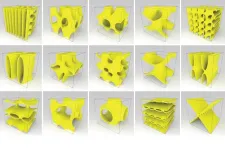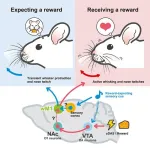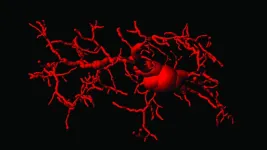(Press-News.org) ‘A place for everything and everything in its place’–making sense of order, or disorder, helps us understand nature. Animals tend to fit nicely into categories: Mammals, birds, reptiles, whatever an axolotl is, and more. Sorting also applies to materials: Insulator, semiconductor, conductor, and even superconductor. Where exactly a material lands in the hierarchy depends on a seemingly invisible interplay of electrons, atoms, and their surroundings.
Unlike animals, the boundaries are less sharp, and tweaking a material’s environment can force it to bounce between categories. For example, dialing down the temperature will turn some materials into superconductors. Snapping on a magnetic field might reverse this effect. Within a single category, different types of order, or phases, can emerge from the sea of particles. Unfortunately, we can’t see this nanoscopic universe with our eyes, but scientists can use advanced imaging tools to visualize what’s going on. Every once in a while, they uncover unexpected and surprising behaviors.
“The discovery of new phases of matter is one of the holy grails in physics and often generates a lot of excitement because it can change our way of thinking and seeing, and even transform how we understand the behavior of quantum particles,” said physics professor Vidya Madhavan.
Led by Madhavan, researchers from the University of Illinois, the University of Maryland, WashU, and the National Institute of Standards and Technology, have now seen unusual waves of charge within a crystal of uranium ditelluride (UTe2). Theorists on the team developed a model that links the experimental observations to a previously unseen facet of the crystal’s unusual superconductivity. The findings, initially shared at a conference last year, inspired other researchers at Cornell University to measure complementary features of the superconductivity directly. Both results were published in the June 28 issue of Nature.
Superconductors were only discovered in the 1900s and scientists are still working to explain the myriad of materials that fall into this category. This work is the latest in a string of results regarding the superconductor UTe2. Researchers from the groups of Nicholas Butch at NIST and Johnpierre Paglione at University of Maryland supplied the crystals for this study. At ambient temperatures, UTe2 is rather unremarkable and resembles a bit of shiny, molten rock. As the material is chilled with liquid helium, it begins to conduct electricity without heating up – this is called superconductivity.
Regular conductivity, the movement of electrons that powers appliances, is mainly a single-particle effect. This means that scientists can explain and predict typical conductivity largely without accounting for the physics of electron-electron interactions. Superconductivity is quite different because it involves electrons interacting to form what are called Cooper pairs.
Pairing is not the same for all materials, and so superconductivity comes in more than one flavor. For example, each electron has a property called spin, which can be oriented in one of two ways: up or down. When two electrons bind together, they can have their spins oriented in opposite directions or in the same direction. This latter one is called triplet pairing and is a rare bird in the world of superconductivity. Over the last few years scientists in this collaboration, as well as in other groups, have made measurements indicating that UTe2 has triplet pairing.
In this study, experimentalists from Madhavan’s group used a scanning tunneling microscope (STM) to visualize the microscopic structure of the material. There are no lenses or mirrors in this microscope. Rather electrons provide a sensitive window into the structure of UTe2. In the microscope, a tungsten tip sweeps across the surface of the material with sub-nanometer resolution. Both the tip and the material are part of an electrical circuit, with electrons scooting through vacuum from tip to material. Quantum tunneling causes this movement and is where the device gets its name. The setup operates at 300 millikelvin and magnetic fields up to around 11 Tesla. The STM revealed that the distribution of electrical charge was not uniform—instead there were stripes.
“We discovered the existence of a charge density wave in the superconducting state, but this by itself is not necessarily unusual. What is strange is that destroying the superconductivity also makes the charge wave goes away,” said Anuva Aishwarya, lead author and a physics graduate student in Madhavan’s group who has been relentlessly chasing down the physics of UTe2 and other exotic materials.
The team did Fourier analysis on the data, which clearly showed charge density waves were present at low magnetic fields, and then vanished above 10 Tesla, where the superconductivity melted away. This was one of the key signals that the waves were somehow intertwined with the material’s superconductivity.
Theorists Julian May-Mann and physics professor Eduardo Fradkin from UIUC provided an explanation for these observations. According to the team, the charge density waves are spawned by an entirely different wave in the material, one that is made up of Cooper pairs. Neither of these waves ebb and flow like water. Instead, they are static variations in two different properties—one relates to the charge and the other to the interacting electron pairs. Together the waves provide insights into the types of order that occur in UTe2. Interwoven parent-daughter waves can also appear in other superconductors that contain copper and oxygen atoms. This new study is the first time that scientists have seen evidence for this in a superconductor with triplet pairing.
“This is very exciting to me. If this charge density wave is originating with a triplet pair density wave then there may be a fundamentally new phase that has come up in this material because of very strong electron interactions,” said Aishwarya.
Paper references:
Aishwarya, A., May-Mann, J., Raghavan, A. et al. Magnetic-field-sensitive charge density waves in the superconductor UTe2. Nature 618, 928–933 (2023). https://doi.org/10.1038/s41586-023-06005-8
Nature News and Views article: Nature 618, 910-912 (2023) doi: https://doi.org/10.1038/d41586-023-01996-w
END
Waves of charge signal rare physics at work inside a superconductor
2023-08-02
ELSE PRESS RELEASES FROM THIS DATE:
New method simplifies the construction process for complex materials
2023-08-02
Engineers are constantly searching for materials with novel, desirable property combinations. For example, an ultra-strong, lightweight material could be used to make airplanes and cars more fuel-efficient, or a material that is porous and biomechanically friendly could be useful for bone implants.
Cellular metamaterials — artificial structures composed of units, or cells, that repeat in various patterns — can help achieve these goals. But it is difficult to know which cellular structure will lead to the desired properties. Even if one focuses on structures made of smaller building blocks like interconnected beams or ...
Dimensions to boost discoverability of Oxford University Press online journals and books
2023-08-02
The world’s largest linked research database, Dimensions, will grow its knowledge base even further, thanks to a new partnership with the world’s largest university press, Oxford University Press (OUP).
Under the agreement, more than 27,000 books and 500 journal titles from OUP’s Oxford Academic digital publishing platform will be fully indexed and discoverable in Dimensions, adding another rich resource of academic material to the world’s largest research database, in fields such as the arts, humanities, economics, science, technology, history, and politics.
The move will enable users of Dimensions – a flagship Digital Science product – ...
A visual feast
2023-08-02
3D light sculptures. Tsunami waves on a beach. Previewing color tattoos. Contributions from the Bickel and Wojtan groups at the Institute of Science and Technology Austria (ISTA) to the 2023 SIGGRAPH conference tackle an impressive variety of classic and novel questions. While their focuses range from computer graphics to fabrication methods, the computer scientists are united in finding cost-effective, innovative solutions and empowering users.
SIGGRAPH is the top worldwide annual convention for computer graphics and interactive techniques, bringing ...
Important step toward next-generation probiotics
2023-08-02
One of the beneficial gut bacteria residing in the human gut, which normally cannot survive in an environment with oxygen, can now be made oxygen-tolerant. This is a key finding in the development of future probiotic treatment that is now being explored to improve glucose control in individuals with prediabetes.
Our intestines are home to trillions of bacteria, the gut microbiota, which are important for functions such as digesting food and educating and activating the immune system. During the past decade it has been clarified that changes in the bacterial composition can be linked to various diseases.
Significant expectations have been attributed to the next generation ...
Infertility may lead to more severe menopause symptoms
2023-08-02
CLEVELAND, Ohio (August 2, 2023)—Not all women experience menopause the same way. The severity of menopause symptoms is influenced by a multitude of behavioral, biological, social, psychological, and demographic factors. A new study suggests that infertility may also be a risk factor for some menopause symptoms, including depressive mood, irritability, and sleep problems. Results of the study are published online today in Menopause, the journal of The Menopause Society.
A woman’s reproductive history has been implicated as a factor in the timing of menopause onset and the prevalence of menopause ...
Unveiling the mechanism underlying orofacial movements during reward processing in animals
2023-08-02
In animals, movements such as locomotion or grooming are known to influence neuronal activity within the cerebral cortex. Moreover, recent studies also suggest that these changes in neuronal activity are not confined to a specific area but are pervasive throughout cortical and subcortical regions of the brain. Interestingly, in animals trained for reward-based learning tasks, such spontaneous movements—despite being uninstructed and unnecessary—may be aligned to task events and may significantly contribute to ...
How immunity contributes to ageing and neurodegeneration
2023-08-02
As we age, our bodies undergo various changes that can impact our overall health and make us more susceptible to diseases. One common factor in the ageing process is low-grade inflammation, which contributes to age-related decline and impairment. However, the precise pathways responsible for this inflammation and their impact on natural ageing have remained elusive until now.
A new study led by Andrea Ablasser at EPFL now shows that a molecular signaling pathway called cGAS/STING, plays a critical role in driving chronic inflammation and functional decline during aging. By blocking the STING protein, the researchers were able to suppress inflammatory responses in senescent ...
Cost of translating consent documents may serve as a barrier to participation of members of underrepresented groups in clinical trials
2023-08-02
Cancer research centers conducting clinical trials could enroll more patients from underrepresented racial and ethnic groups by placing greater emphasis on relieving investigators of the costs of translating consent documents into languages other than English, according to a UCLA Jonsson Comprehensive Cancer Center study.
“We identified a readily addressable weakness in the clinical trial process, and we believe that overcoming this barrier, as we have begun to do, will ensure better representation of trial participants from traditionally underrepresented racial and ethnic groups, ...
Nature’s kitchen – how a chemical reaction used by cooks helped create life on Earth
2023-08-02
Maillard reaction locks away 4 million tonnes of organic carbon a year
Process helped stabilise conditions for complex life to evolve
A chemical process used in the browning of food to give it its distinct smell and taste is probably happening deep in the oceans, where it helped create the conditions necessary for life.
Known as the Maillard reaction after the French scientist who discovered it, the process converts small molecules of organic carbon into bigger molecules known as polymers. In ...
Genetic variant linked to lower levels of HIV virus in people of African ancestry
2023-08-02
An international team of researchers has found a genetic variant that may explain why some people of African ancestry have naturally lower viral loads of HIV, reducing their risk of transmitting the virus and slowing progress of their own illness.
Reported today in Nature, this is the first new genetic variant related to HIV infection discovered in nearly 30 years of research. It could, in the future, help direct the development of new treatments approaches for those living with HIV.
HIV remains a major threat to global health. According to UNAIDS, there were 38.4 million people living with HIV globally in 2021. A combination of pre-exposure drugs and medicines that dramatically ...







